Characterization of the Lime Mortars of the Rui Barbosa House Museum in Rio De Janeiro, Brazil
Abstract
:1. Introduction
2. Rui Barbosa House Museum
3. Materials and Methods
3.1. Sampling
- (i)
- S-001 to S-004: four samples from the South side (façade).
- (ii)
- S-005 to S-007: three from the East side.
- (iii)
- S-008 to S-010: three from the North side.
- (iv)
- S-011 and S-012: two samples from the West side.
3.2. Methods
4. Results and Discussion
4.1. Macroscopic Description, Observation, and Raman Spectroscopy
4.2. Mineralogical and Petrographic Characterization
4.2.1. Mineralogical Analysis
4.2.2. Petrographic Analysis
4.3. Chemical Characterization
4.3.1. WDXRF Analysis
- (i)
- All samples contain high percentages of both quartz and calcite;
- (ii)
- The high silica content can be linked to the percentage of quartz present in mortars and can be influenced also by the use of natural hydraulic lime. For this reason, future studies are needed to determine the type of binder from Rui Barbosa House Museum;
- (iii)
- There are comparatively lower amounts (often only traces) of kaolinite, microcline, muscovite, and albite.
4.3.2. FTIR Analysis
4.4. Physical Analysis of the Mortars
4.5. Reconstitution of Mortar
4.6. Thermogravimetric Analyses
4.7. Pollution in the Mortars Surfaces
5. Conclusions
Acknowledgments
Author Contributions
Conflicts of Interest
References
- Chiari, G.; Santarelli, M.; Toracca, G. Caraterizzazione delle malte antiche mediante l’analisi di campioni non frazionati. Mater. Struct. 1992, 1, 111–137. [Google Scholar]
- Como, M. Statics of Historic Masonry Constructions; Springer: Berlin/Heidelberg, Germany, 2013. [Google Scholar]
- Bertolini, L.; Carsana, M.; Gastaldi, M.; Lollini, F.; Redaelli, E. Binder characterization of mortars used at different ages in the San Lorenzo church in Milan. Mater. Charact. 2013, 80, 9–20. [Google Scholar] [CrossRef]
- Chiarelli, N.; Miriello, D.; Bianchi, G.; Fichera, G.; Giamello, M.; Memmi, I.T. Characterization of ancient mortars from the S. Niccoló archaeological complex in Montieri (Tuscany Italy). Constr. Build. Mater. 2015, 96, 442–460. [Google Scholar] [CrossRef]
- Gleize, P.; Motta, E.; Silva, D.; Roman, H. Characterization of historical mortars from Santa Catarina (Brazil). Cem. Concr. Compos. 2009, 31, 342–346. [Google Scholar] [CrossRef]
- Maria, S. Methods for porosity measurement in lime-based mortars. Constr. Build. Mater. 2010, 24, 2572–2578. [Google Scholar] [CrossRef]
- Santiago, C.C. O Restauro de Argamassa de cal no Brasil; Construindo: Belo Horizonte, Brazil, 2012. [Google Scholar]
- Bakolas, A.; Biscontin, G.; Moropoulou, A.; Zendri, E. Characterization of structural byzantine mortars by thermogravimetric analysis. Thermochim. Acta 1998, 321, 151–160. [Google Scholar] [CrossRef]
- Moropoulou, A.; Bakolas, A.; Bisbikou, K. Characterization of ancient, byzantine and later historic mortars by thermal and X-ray diffraction techniques. Thermochim. Acta 1995, 269, 779–795. [Google Scholar] [CrossRef]
- Moropoulou, A.; Bakolas, A.; Bisbikou, K. Investigation of the technology of historic mortars. J. Cult. Herit. 2000, 1, 45–58. [Google Scholar] [CrossRef]
- Biscontin, G.; Birelli, M.P.; Zendri, E. Characterization of binders employed in the manufacture of Venetian historical mortars. J. Cult. Herit. 2002, 3, 31–37. [Google Scholar] [CrossRef]
- Freidin, C.; Meir, I. Byzantine mortars of the Negev Desert. Constr. Build. Mater. 2005, 19, 19–23. [Google Scholar] [CrossRef]
- Zeng, Y.; Zhang, B.; Liang, X. A case study and mechanism investigation of typical mortars used on ancient architecture in China. Thermochim. Acta 2008, 473, 1–6. [Google Scholar] [CrossRef]
- Adriano, P.; Silva, A.S.; Veiga, R.; Mirao, J.; Candeias, A. Microscopic characterisation of old mortars from the Santa Maria Church in Évora. Mater. Charact. 2009, 60, 610–620. [Google Scholar] [CrossRef]
- Budak, M.; Akkurt, S.; Bke, H. Evaluation of heat treated clay for potential use in intervention mortars. Appl. Clay Sci. 2010, 49, 414–419. [Google Scholar] [CrossRef]
- Sanjurjo-S_anchez, J.; Trindade, M.; Blanco-Rotea, R.; Garcia, R.B.; Mosquera, D.F.; Burbidge, C.; Prudêncio, M.; Dias, M. Chemical and mineralogical characterization of historic mortars from the Santa Eulalia de Bóveda temple, NW Spain. J. Archaeol. Sci. 2010, 37, 2346–2351. [Google Scholar] [CrossRef]
- Martínez, I.; Castillo, A.; Martínez, E.; Castellote, M. Physico-chemical material characterization of historic unreinforced masonry buildings: The first step for a suitable intervention. Constr. Build. Mater. 2013, 40, 352–360. [Google Scholar] [CrossRef]
- Lezzerini, M.; Legnaioli, S.; Lorenzetti, G.; Palleschi, V.; Tamponi, M. Characterization of historical mortars from the bell tower of St. Nicholas Church (Pisa, Italy). Constr. Build. Mater. 2014, 69, 203–212. [Google Scholar] [CrossRef]
- Leone, G.; Vita, A.D.; Magnani, A.; Rossi, C. Characterization of archaeological mortars from Herculaneum. Thermochim. Acta 2016, 624, 86–94. [Google Scholar] [CrossRef]
- Moropoulou, A.; Polikreti, K.; Bakolas, A.; Michailidis, P. Correlation of physicochemical and mechanical properties of historical mortars and classification by multivariate statistics. Cem. Concr. Res. 2003, 33, 891–898. [Google Scholar] [CrossRef]
- Da Cultura, M. Fundação Casa Rui Barbosa. 2016. Available online: www.casaruibarbosa.gov.br (accessed on 5 June 2016).
- NPArq, Núcleo de Preservação Arquitetônica, Centro de Memória e Informação, Caderno de Apoio a Elaboração do Caderno de Encargos: Conservação das Superfícies Arquitetônicas do Museu Casa de Rui Barbosa; Tech. Rep.; IPHAN: Rio de Janeiro, Brasil, 2015.
- Walentaa, G.; Füllmannb, T. Advances in quantitative XRD analysis for clinker, cements, and cementitious additions. Powder Diffr. 2004, 19, 40–44. [Google Scholar] [CrossRef]
- Genestar, C.; Pons, C.; Más, A. Analytical characterization of ancient mortars from the archaeological Roman city of Pollentia (Balearic Islands, Spain). Anal. Chim. Acta 2006, 557, 373–379. [Google Scholar] [CrossRef]
- Rodrigues, P.N. Caracterização das Argamassas Históricas da Ruína de São Miguel Arcanjo/RS. Master’s Thesis, Universidade Federal de Santa Maria, Santa Maria, Brazil, 2013. [Google Scholar]
- Saikia, B.J.; Parthasarathy, G. Fourier Transform Infrared Spectroscopic Characterization of Kaolinite from Assam and Meghalaya, Northeastern India. J. Mod. Phys. 2010, 1, 206–210. [Google Scholar] [CrossRef]
- Sivakumar, S.; Ravisankar, R.; Raghu, Y.; Chandrasekaran, A.; Chandramohan, J. FTIR Spectroscopic Studies on Coastal Sediment Samples from Cuddalore District, Tamilnadu, India. Indian J. Adv. Chem. Sci. 2012, 1, 40–46. [Google Scholar]
- Sivakumar, S.; Ravisankar, R.; Govardhavan, B.; Anand, D.P.; Jebakumar, J.P.P. Mineral Identification of Coastal Sediment Sample from Karaikal Pondicherry, India by FT-IR Spectroscopic Technique. Sci. Acta Xaver. 2010, 5, 75–82. [Google Scholar]
- Moropoulou, A.; Bakolas, A.; Anagnostopoulou, S. Composite materials in ancient structures. Cem. Concr. Compos. 2005, 27, 295–300. [Google Scholar] [CrossRef]
- Teutonico, J.M. A Laboratory Manual for Architectural Conservators; ICCROM: Rome, Italy, 1988. [Google Scholar]
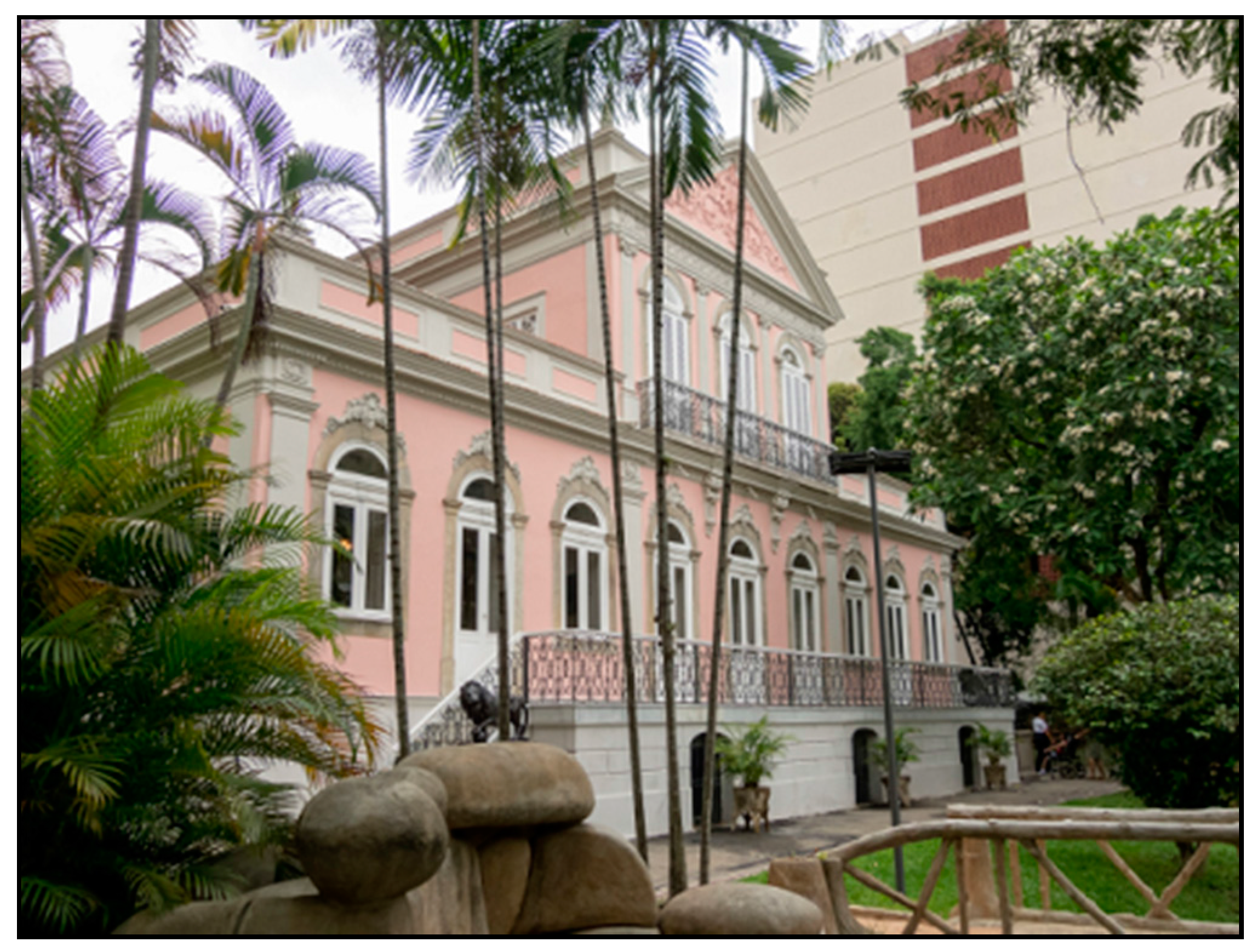
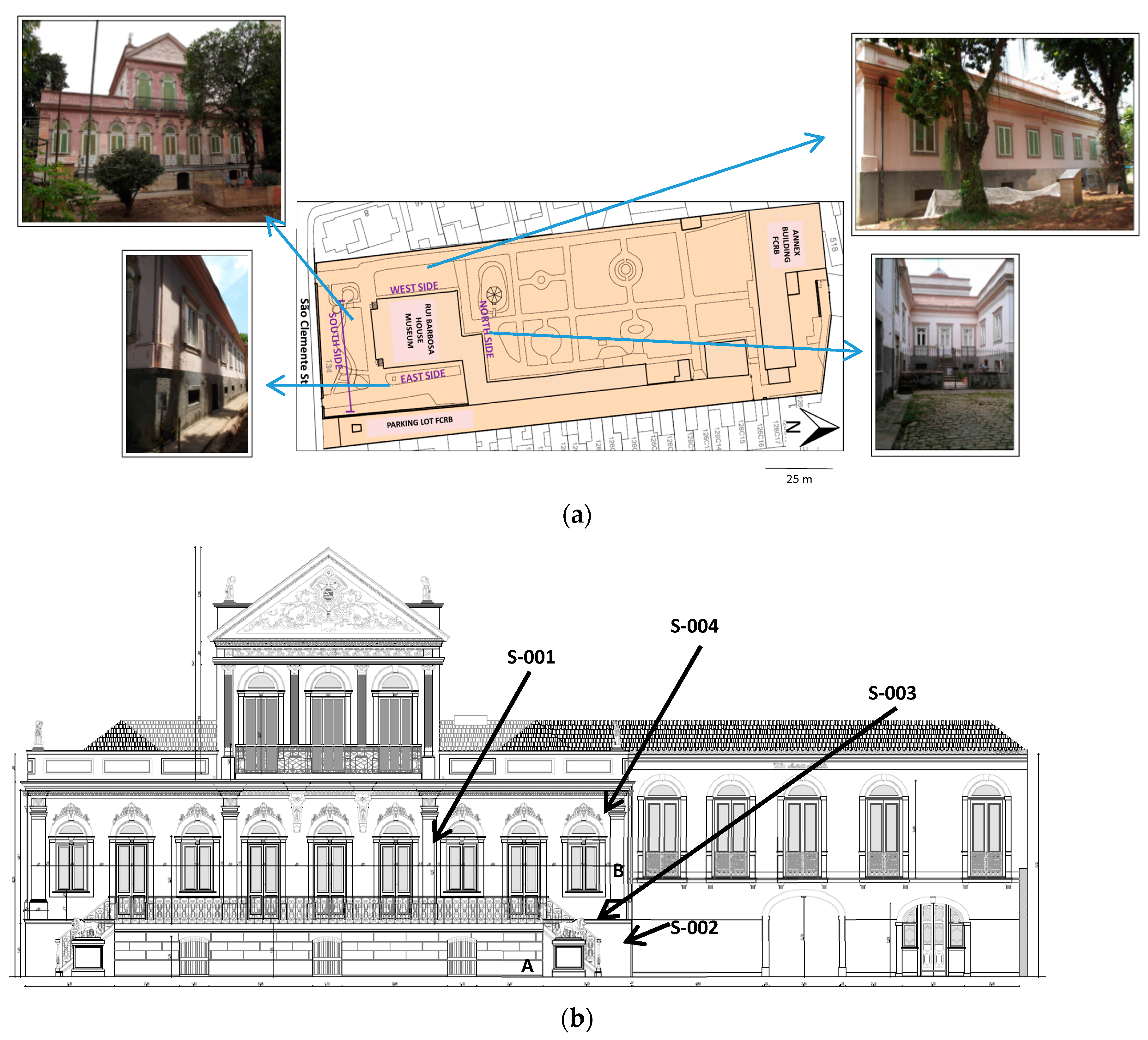
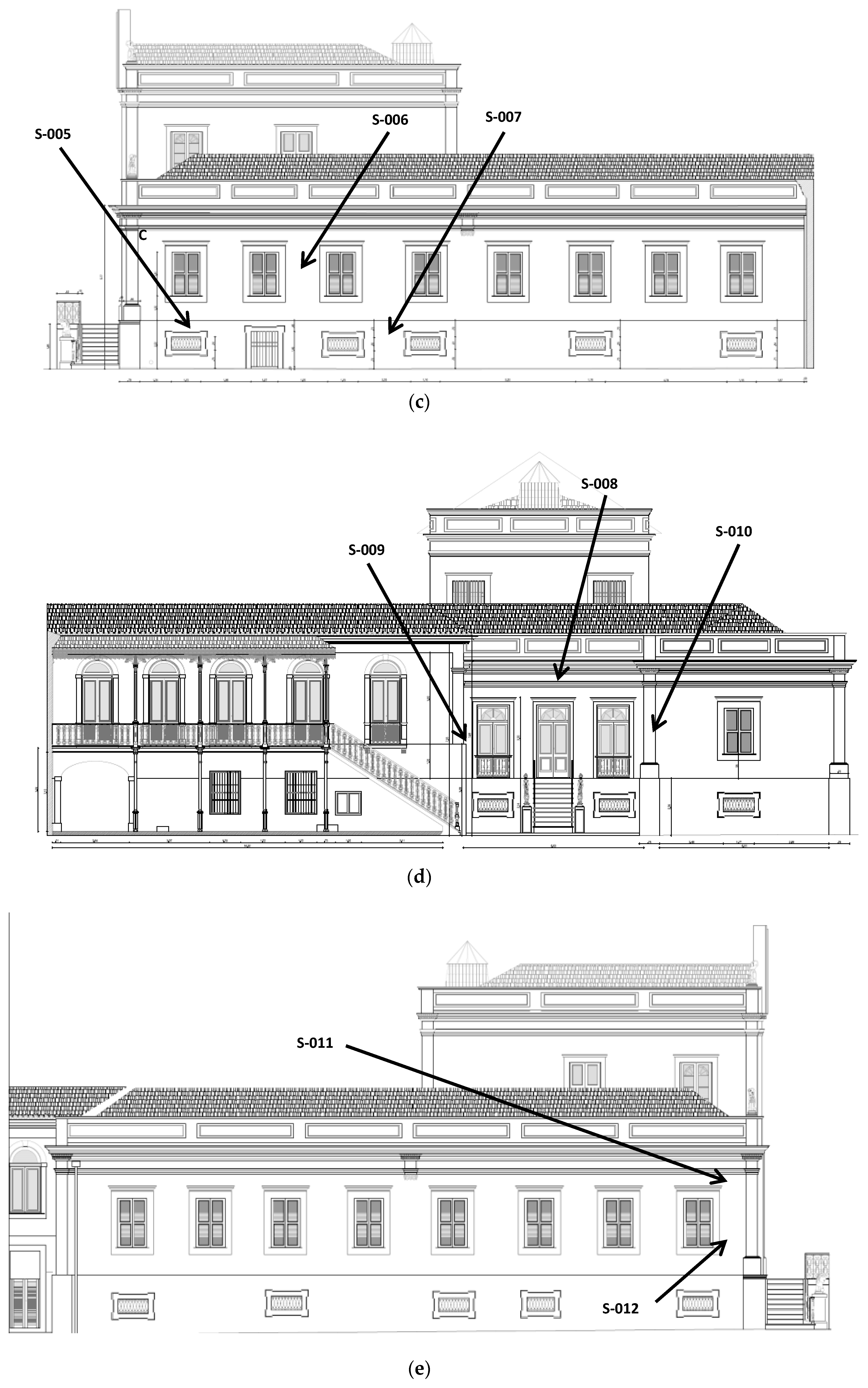

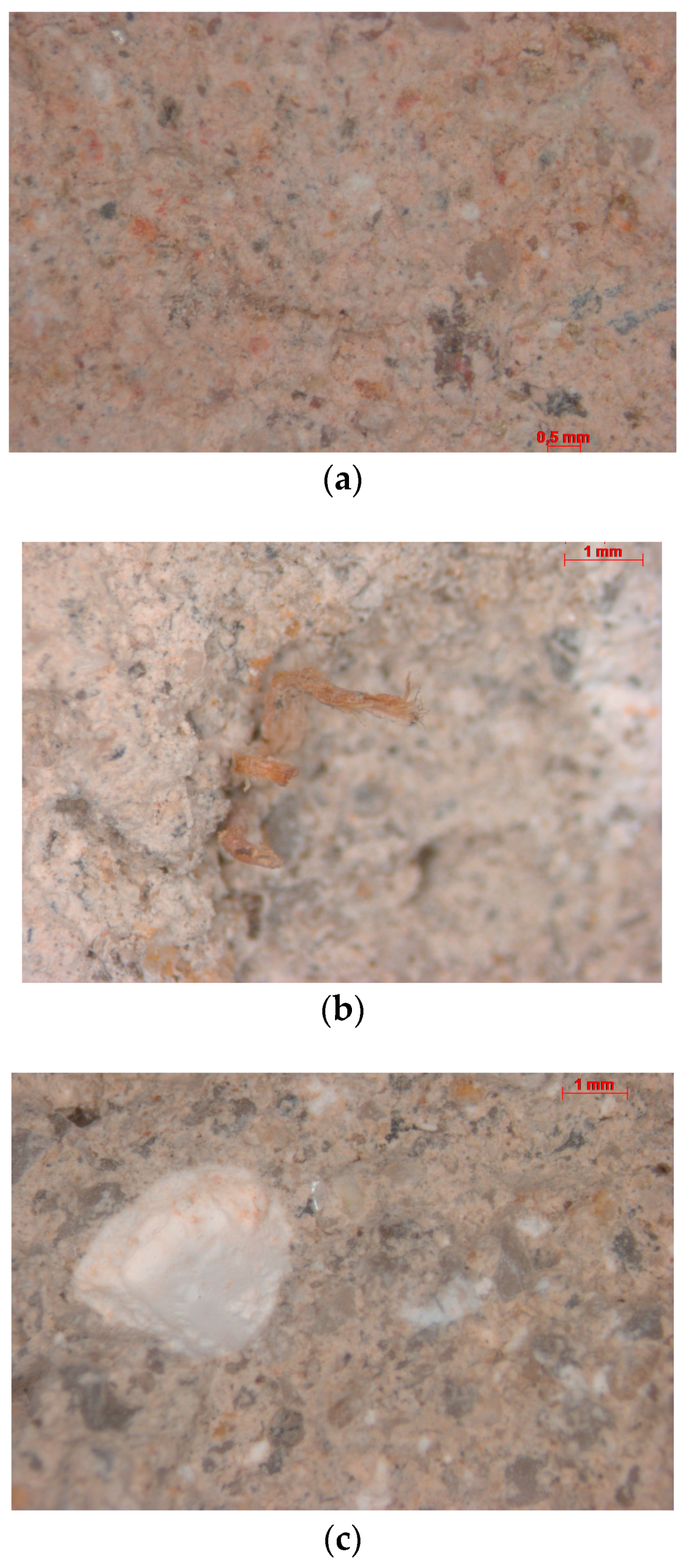
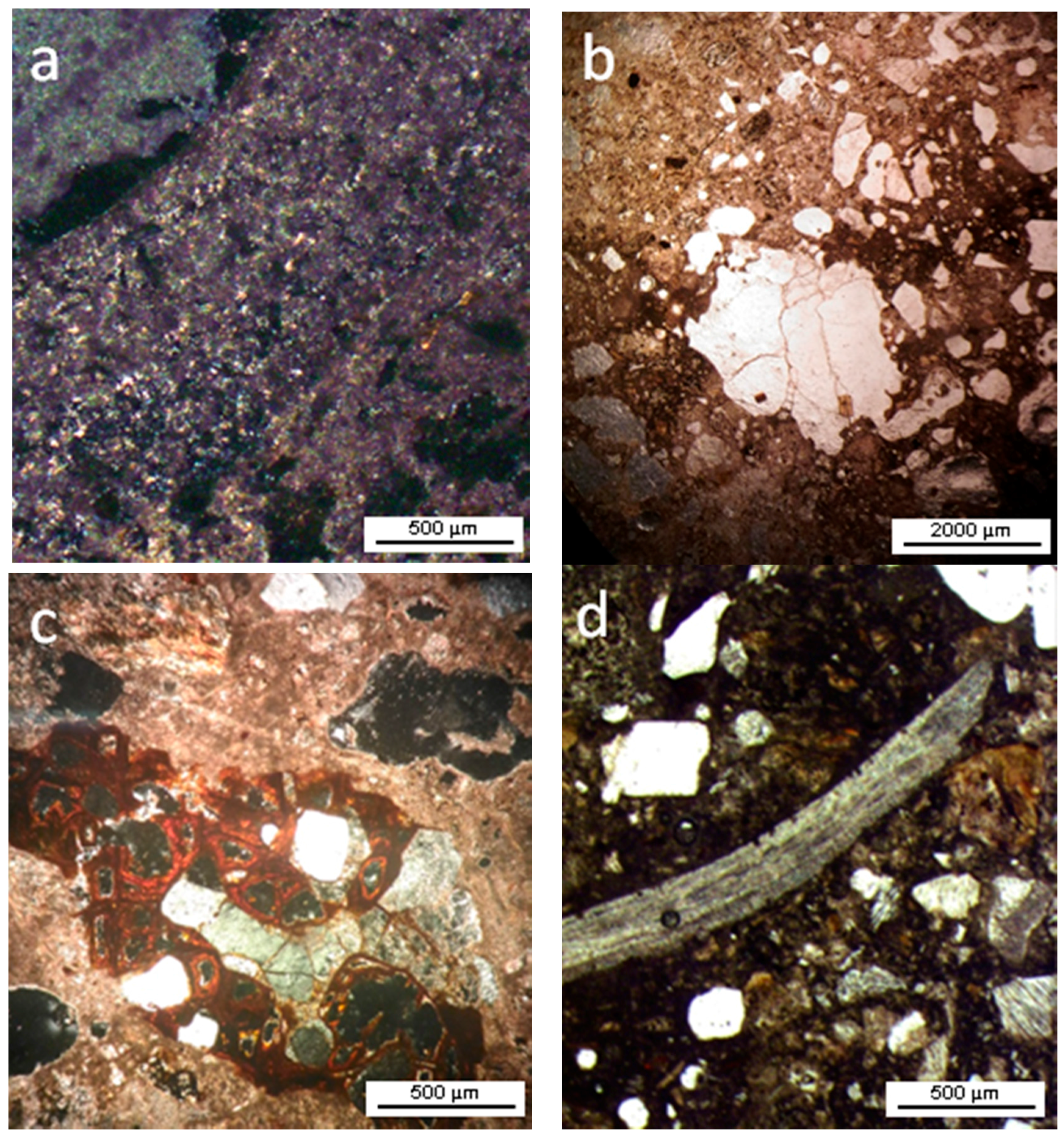

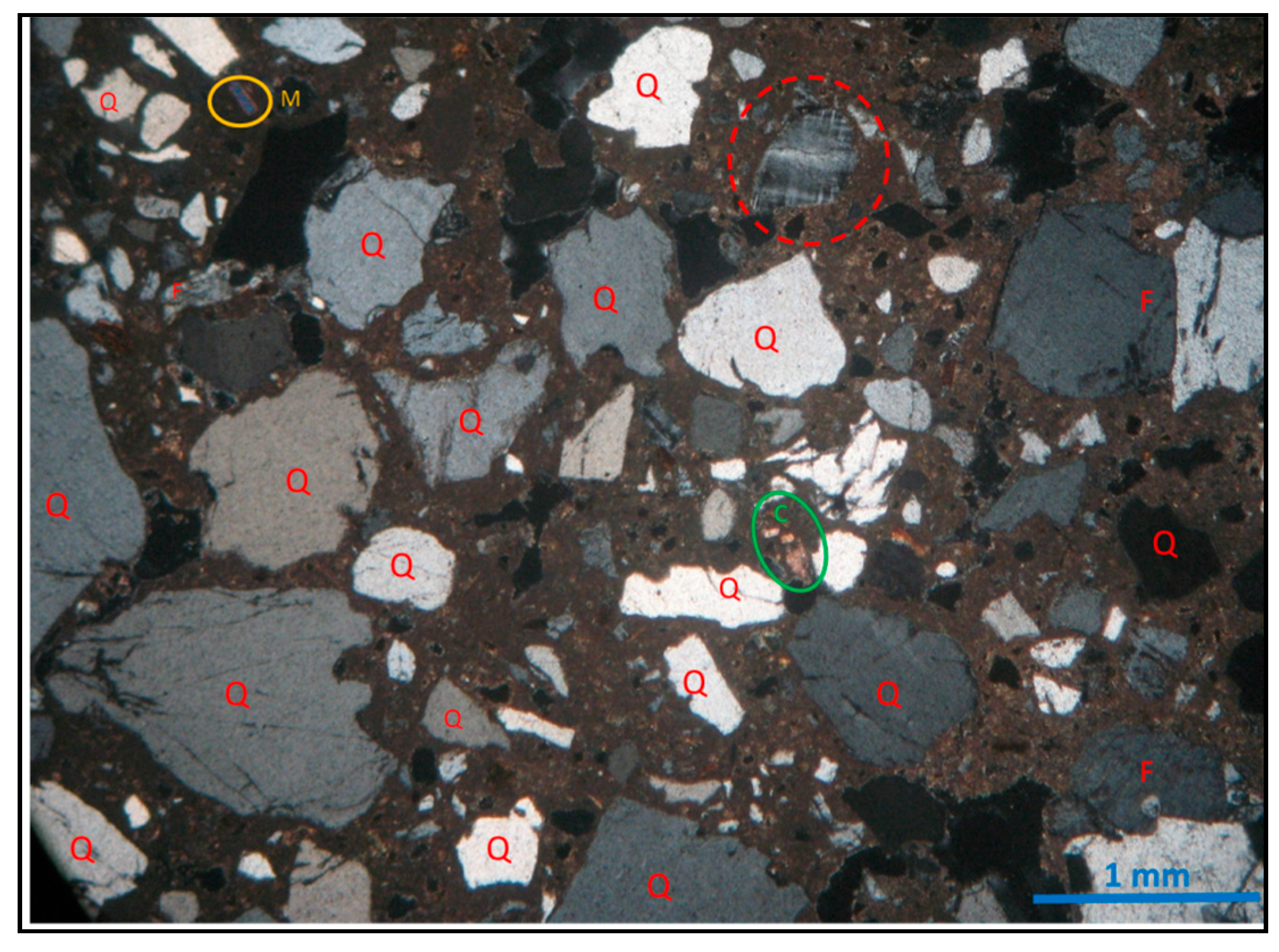
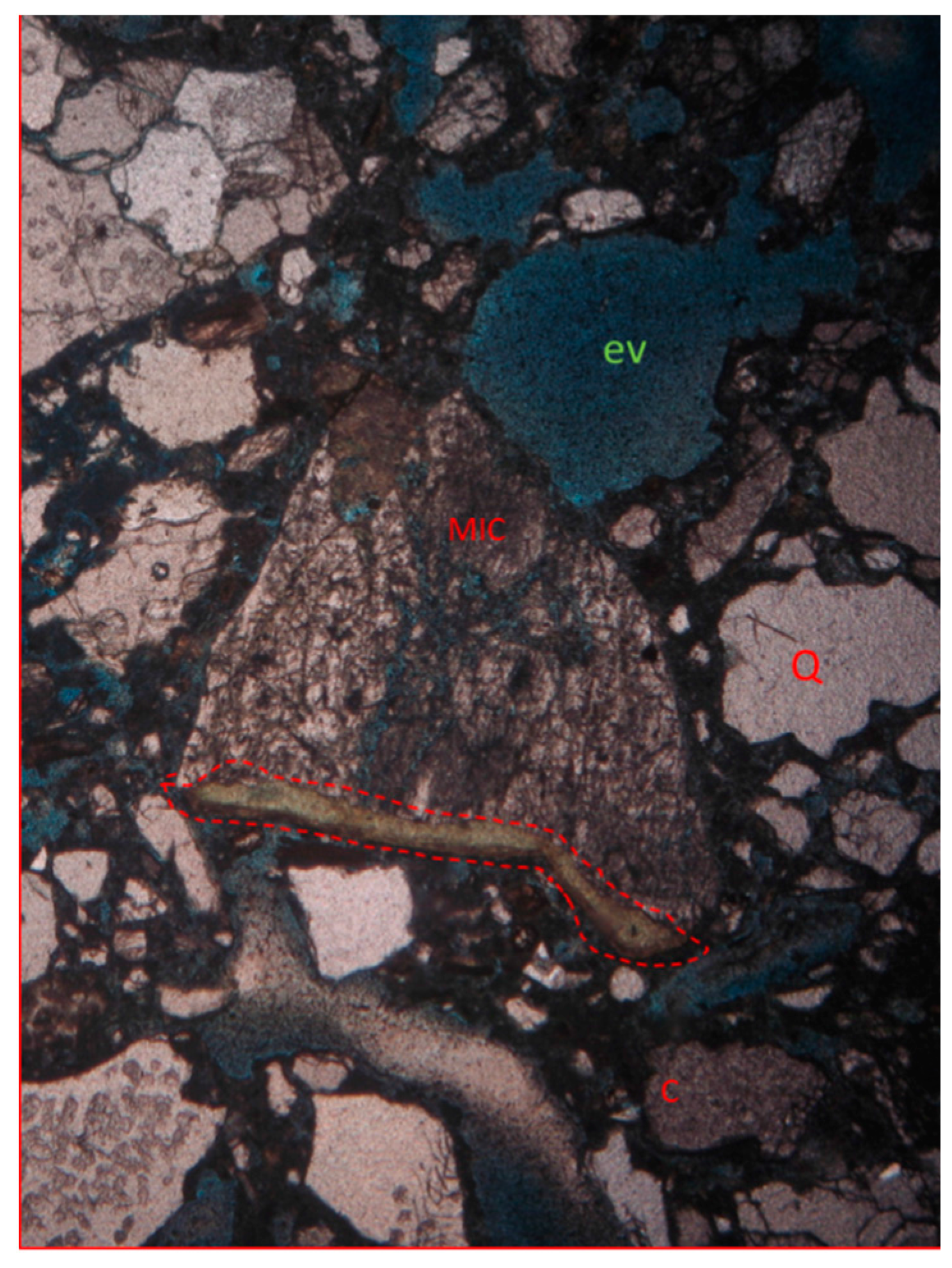
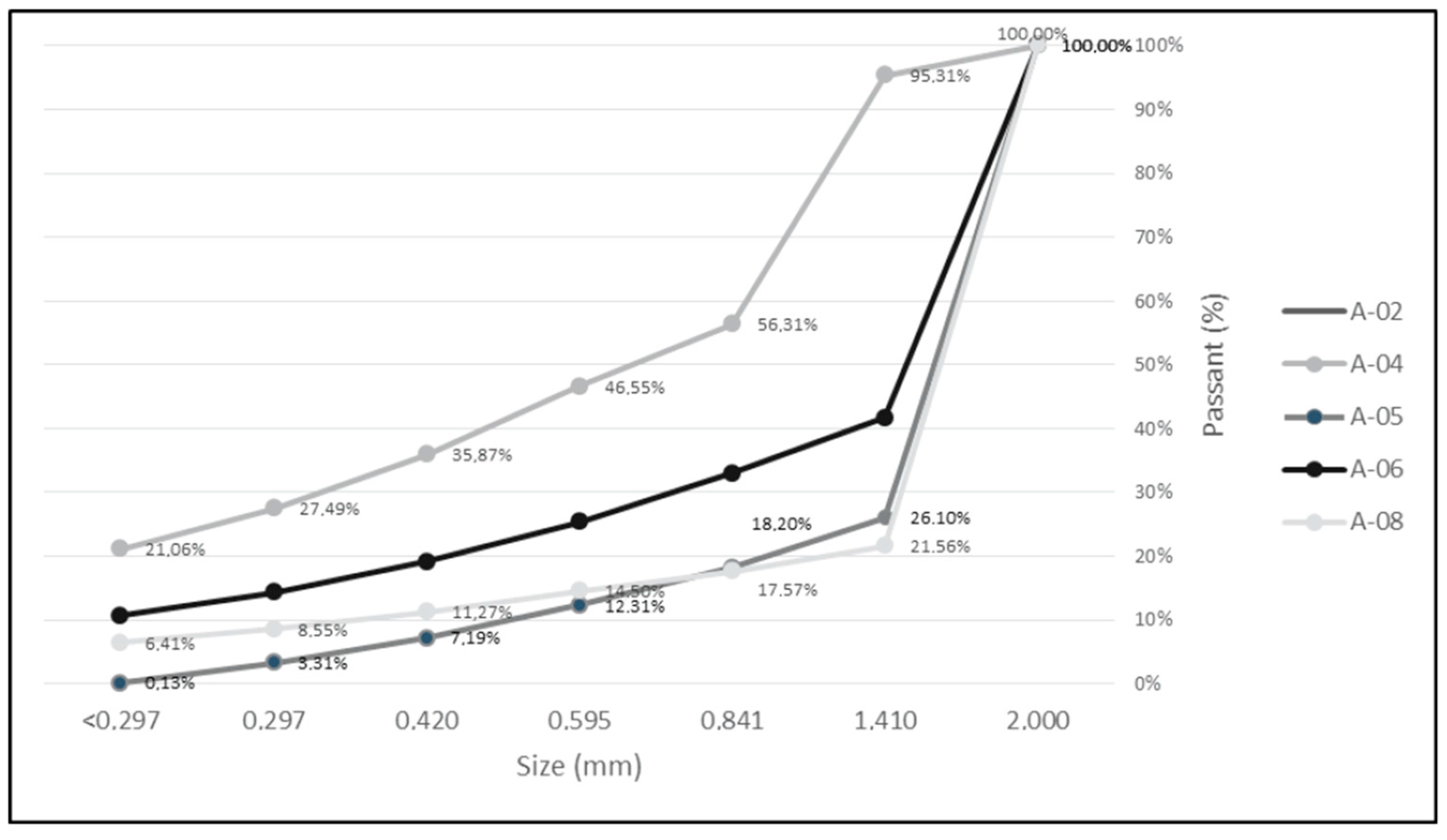

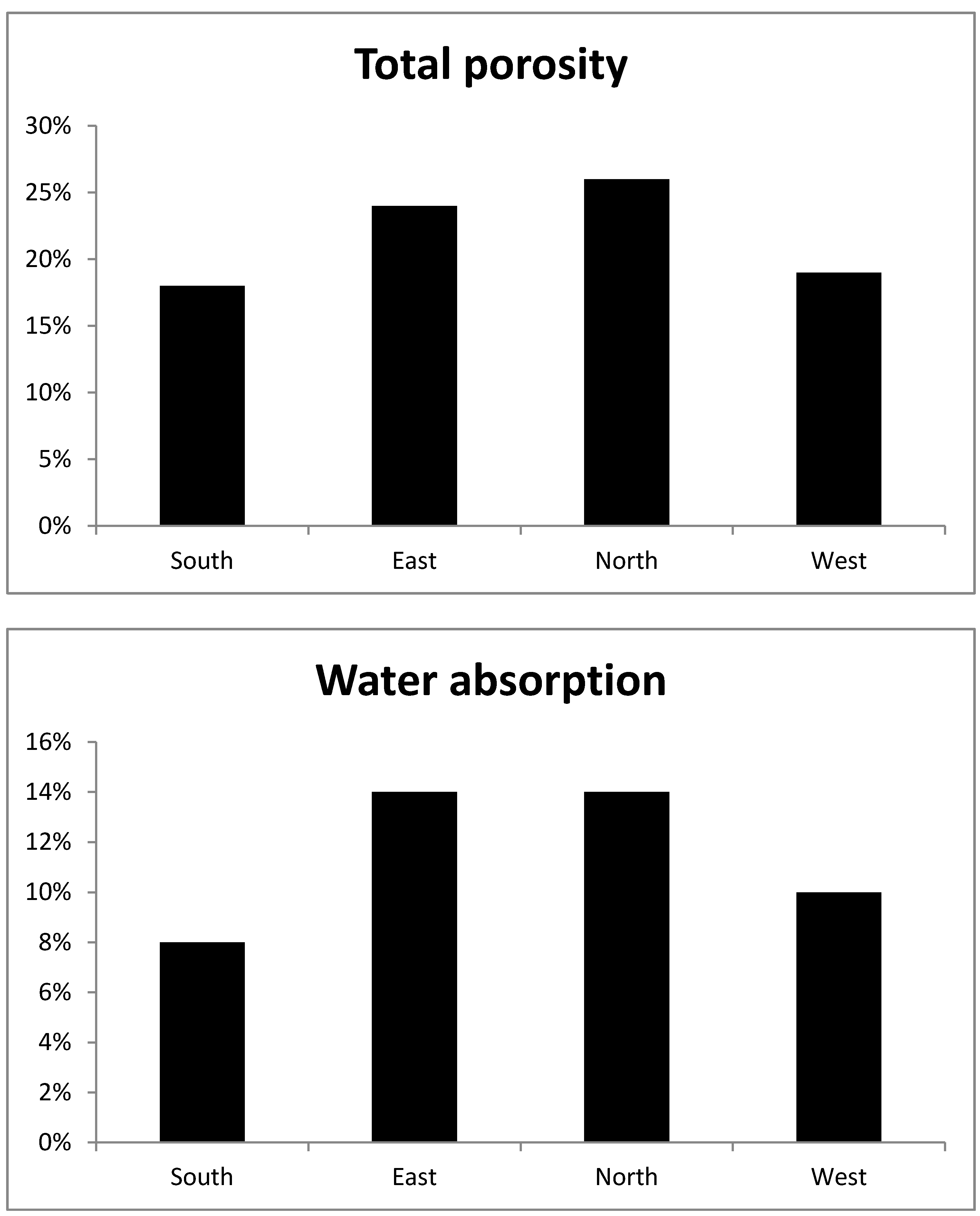
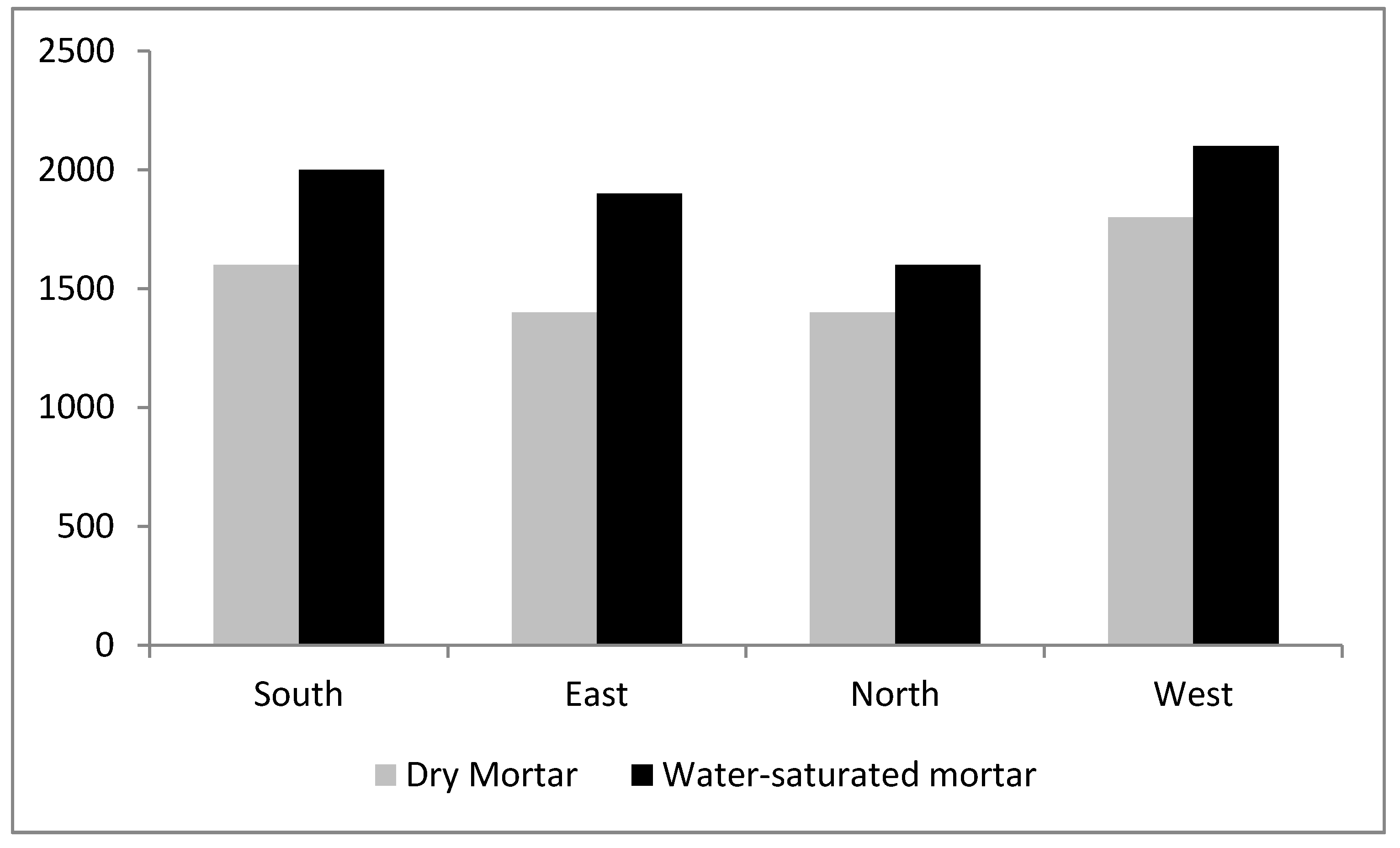
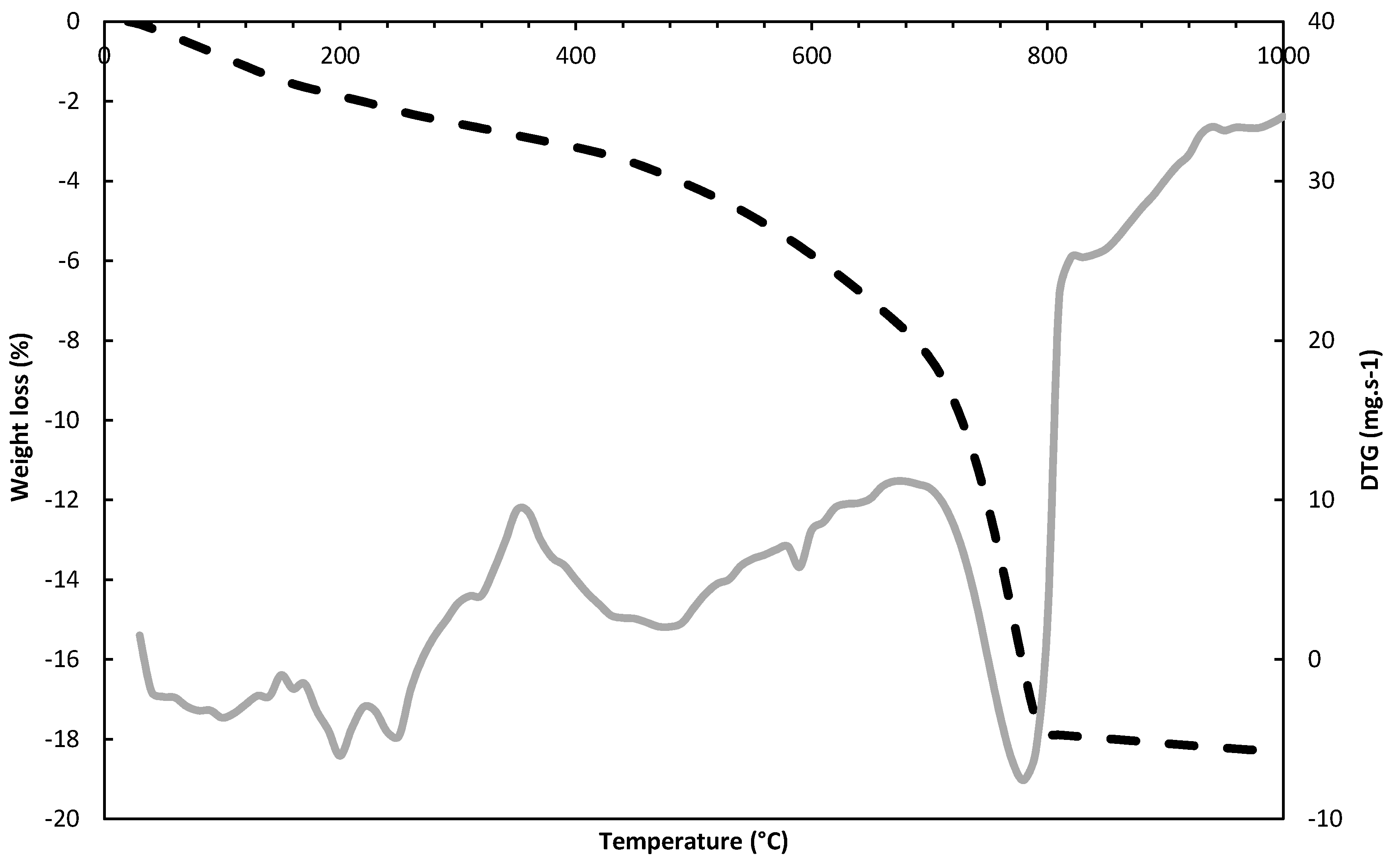
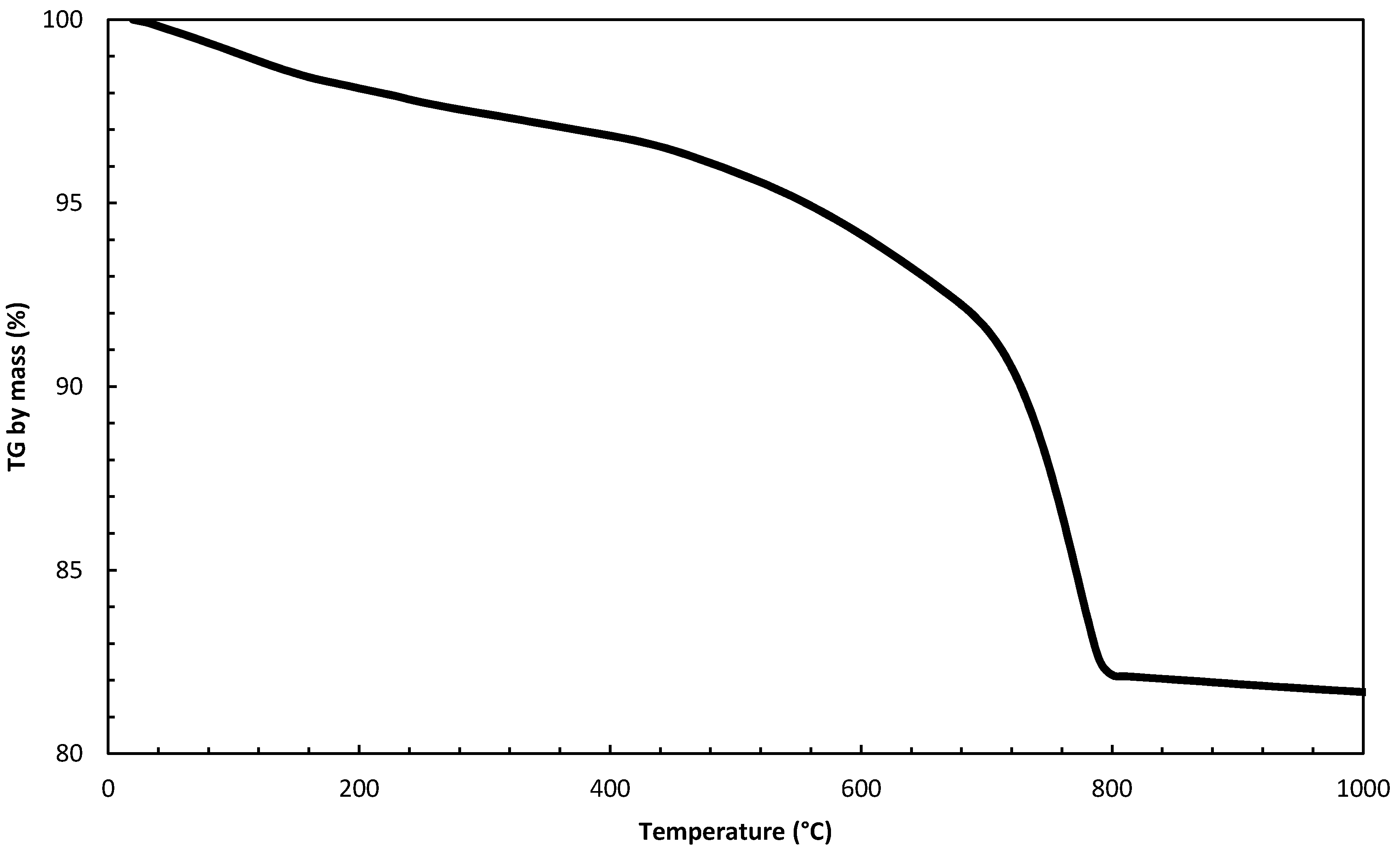
| Sample | Quartz | Calcite | Kaolinite | Microcline | Muscovite | Albite | Dolomite |
|---|---|---|---|---|---|---|---|
| S-001 | +++ | +++ | t | + | + | t | t |
| S-002 | +++ | ++ | +++ | ++ | + | t | t |
| S-003 | +++ | ++ | ++ | ++ | + | t | t |
| S-004 | +++ | + | + | + | + | t | t |
| S-005 | + | +++ | ++ | + | + | + | +++ |
| S-006 | +++ | ++ | ++ | + | + | t | t |
| S-007 | +++ | ++ | + | + | + | t | t |
| S-008 | +++ | ++ | + | + | ++ | t | t |
| S-009 | +++ | + | - | t | t | - | t |
| S-010 | +++ | ++ | - | t | + | t | t |
| S-011 | +++ | + | - | - | t | t | t |
| S-012 | +++ | + | t | t | + | t | t |
| Phase Name | S-001 | S-002 | S-005 | S-008 | S-012 |
|---|---|---|---|---|---|
| Calcite | 66.6 | 27.9 | 26.7 | 15.4 | 72.2 |
| Quartz | 12.6 | 15.3 | 1.6 | 43.7 | 11.5 |
| Microcline | 2.7 | 10.4 | 6.1 | 12.6 | 2.3 |
| Gypsum | 0.9 | 1.1 | 0.8 | 0.0 | 0.0 |
| Kaolinite | 0.0 | 4.7 | 1.2 | 2.7 | 0.0 |
| Muscovite | 0.0 | 1.5 | 1.1 | 1.3 | 0.3 |
| Pyrophyllite | 0.0 | 0.0 | 1.0 | 0.0 | 0.0 |
| Hornblende magnesium iron | 0.0 | 0.0 | 2.6 | 0.0 | 0.0 |
| Dolomite | 0.0 | 0.0 | 25.1 | 0.0 | 0.0 |
| Talc | 0.0 | 0.0 | 3.3 | 0.0 | 0.0 |
| Barite | 0.0 | 0.0 | 4.7 | 0.0 | 0.0 |
| Pseudorutile | 0.0 | 0.0 | 3.8 | 0.0 | 0.0 |
| Amorphous (CSH) | 17.2 | 39.0 | 22.0 | 24.3 | 13.7 |
| Total | 100.0 | 100.0 | 100.0 | 100.0 | 100.0 |
| Sample | Side | SiO2 | TiO2 | Al2O3 | Fe2O3 | MgO | CaO | Na2O | K2O | SO3 | LOI |
|---|---|---|---|---|---|---|---|---|---|---|---|
| S-001 | South | 33.20 | 0.29 | 10.70 | 2.50 | 0.80 | 29.20 | 0.64 | 1.80 | 0.87 | 19.70 |
| S-002 | South | 58.40 | 0.13 | 7.60 | 1.20 | 0.43 | 18.80 | 0.69 | 1.80 | 0.32 | 10.30 |
| S-003 | South | 56.00 | 0.14 | 7.70 | 1.50 | 0.42 | 19.60 | 0.92 | 2.00 | 0.76 | 10.60 |
| S-004 | South | 55.40 | 0.13 | 7.56 | 1.40 | 0.55 | 18.90 | 0.73 | 2.00 | 0.51 | 10.40 |
| S-005 | East | 1.43 | 0.21 | 6.70 | 1.82 | 29.44 | 28.8 | 0.44 | 1.67 | 0.61 | 28.88 |
| S-006 | East | 61.00 | 0.12 | 4.90 | 0.78 | 0.50 | 19.50 | 0.79 | 1.10 | 0.85 | 10.20 |
| S-007 | East | 61.00 | 0.15 | 8.10 | 1.30 | 0.40 | 16.10 | 0.97 | 1.90 | 0.41 | 9.30 |
| S-008 | North | 64.80 | 0.24 | 15.30 | 1.70 | 0.59 | 6.10 | 1.90 | 3.60 | 0.24 | 5.10 |
| S-009 | North | 70.00 | <0.10 | 1.80 | 0.42 | 0.48 | 16.00 | 0.19 | 0.30 | 0.33 | 10.10 |
| S-010 | North | 69.30 | 0.36 | 9.30 | 1.60 | 1.30 | 8.60 | 0.94 | 2.00 | 0.65 | 5.40 |
| S-011 | West | 60.30 | 0.11 | 6.90 | 1.10 | 0.36 | 16.10 | 0.96 | 1.60 | 0.44 | 11.70 |
| S-012 | West | 70.00 | 0.11 | 6.60 | 1.10 | 0.32 | 12.10 | 0.82 | 1.60 | 0.32 | 7.00 |
| Sample | Silt and Clay (% Fines) | Sand (% Thick) | Fines + Thick (%) | Binder (%) | Fines/Binder (%) | Thick/Binder (%) | Sand (Fines + Thick)/Binder (%) | (Sand:Binder) |
|---|---|---|---|---|---|---|---|---|
| S-002 | 15.88 | 26.27 | 42.14 | 57.86 | 0.27 | 0.45 | 0.73 | 1:1 |
| S-004 | 10.37 | 55.83 | 66.21 | 33.79 | 0.31 | 1.65 | 1.96 | 2:1 |
| S-005 | 4.40 | 73.20 | 77.60 | 22.40 | 0.20 | 3.27 | 3.46 | 3:1 |
| S-006 | 8.12 | 70.42 | 78.53 | 21.47 | 0.38 | 3.28 | 3.66 | 4:1 |
| S-008 | 9.11 | 67.21 | 76.32 | 23.68 | 0.38 | 2.84 | 3.22 | 3:1 |
| S-009 | 6.85 | 67.56 | 74.40 | 25.60 | 0.27 | 2.64 | 2.91 | 3:1 |
| Sample | Method | ||
|---|---|---|---|
| XRPD | WDXRF | [30] | |
| Quartz:Calcite | SiO2:CaCO3 | (Fines + Thick):Binder | |
| S-002 | 1:1 | 1:1 | 1:1 |
| S-004 | 2:1 | 2:1 | 2:1 |
| S-005 | 1:5 | 1:4 | 1:4 |
| S-006 | 5:1 | 4:1 | 4:1 |
| S-008 | 3:1 | 3:1 | 3:1 |
| S-009 | 4:1 | 3:1 | 3:1 |
| Temperature Range | Weight Loss (%) Heating Rate 40 °C/min | Weight Loss (%) Heating Rate 10 °C/min |
|---|---|---|
| 25–120 °C | 1.0 | 1.12 |
| 120–200 °C | 1.0 | 0.62 |
| 200–600 °C | 3.0 | 3.91 |
| >600 °C | 12.0 | 12.25 |
| Total loss | 17.0 | 17.90 |
| Ions | AL-A | AL-B | AL-C |
|---|---|---|---|
| Na+ | 6.40 | 42.30 | 28.70 |
| Al3+ | <0.04 | <0.04 | <0.04 |
| Ca2+ | 90.40 | 186.00 | 178.00 |
| Cl− | 2.50 | <0.02 | 68.00 |
| K+ | 5.40 | 13.50 | 11.30 |
| Fe3+ | <0.06 | 0.30 | <0.06 |
| Mg2+ | 1.30 | 13.60 | 8.20 |
| S2− | 1.90 | 58.90 | 51.40 |
| (SO4)2− | 525.00 | 32.00 | 397.00 |
| (NO3)− | 15.00 | 18.00 | 52.00 |
© 2018 by the authors. Licensee MDPI, Basel, Switzerland. This article is an open access article distributed under the terms and conditions of the Creative Commons Attribution (CC BY) license (http://creativecommons.org/licenses/by/4.0/).
Share and Cite
Pereira da Silva Dalto, D.; Carlos da Conceição Ribeiro, R.; Cavalcanti Rebecchi de Moura, L. Characterization of the Lime Mortars of the Rui Barbosa House Museum in Rio De Janeiro, Brazil. Minerals 2018, 8, 50. https://doi.org/10.3390/min8020050
Pereira da Silva Dalto D, Carlos da Conceição Ribeiro R, Cavalcanti Rebecchi de Moura L. Characterization of the Lime Mortars of the Rui Barbosa House Museum in Rio De Janeiro, Brazil. Minerals. 2018; 8(2):50. https://doi.org/10.3390/min8020050
Chicago/Turabian StylePereira da Silva Dalto, Daniele, Roberto Carlos da Conceição Ribeiro, and Luanna Cavalcanti Rebecchi de Moura. 2018. "Characterization of the Lime Mortars of the Rui Barbosa House Museum in Rio De Janeiro, Brazil" Minerals 8, no. 2: 50. https://doi.org/10.3390/min8020050




